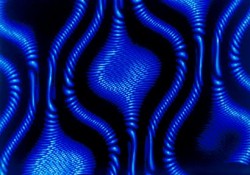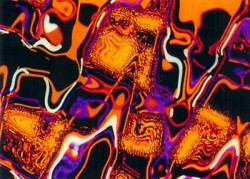Fernando Pontes “Obitjects” 19.10 – 18.11.2000
October 19, 2000 1:17 pm |
| Photography: Object – Language.
Colour – light was always a stimulating element for the artistic creation of Fernando Pontes. It is a constant presence in his installations, in his performances recorded on videos or in photographs, in his experiments with neon light. Always present, light was aesthetically explored and artistically sculpted. The idea of overcoming the concreteness of the real world is one of the strangenesses from this beginning of another time. Now what is establishing itself is a new inventiveness which together with experimentation and the search for ability of another method of technological process, give rise to a work of art where man and machine interact creatively. The work is carried out by man but the machine became co-author. In the case of Fernando Pontes, the extensive amplification of his eye, in previous research, altered his creative thinking and his artistic behaviour. As Marshall mc Luhan predicted: “When parameters change man changes”. This transformation started when the artist attented a workshop at the Goethe Institute in Salvador, Brazil, entitled “Canibalizing Images”, directed by Michael Bleyenberg, a professor from the School of Media Art in Cologne, Germany. Since these experiments F. Pontes has taken the various possibilities of effects from computer software in the dissolution of one photographic image, in infinite recombinations limited only by the artist’s control. Thus, originating from a single photograph the possibilities of formal research and optical allow a sequence not linear in new shapes which suddenly unexpectedly reveal themselves like magic, full of colour and movement, similar to a virtual kaleidoscope. The idea of devouring shapes, overcoming the concreteness of the real, registered photographicaly by digital dematerialization and having as a consequence the register of the initial image emptied to a minimal structure, led him to the following step which was the photographic register of the final result achieved after the completed process and exhibited on the computer screen. Photographic registering is taken with the use of macro lens for maximum approximation to the computer screen, the result is documented by diapositive and negative films. So, the circle closes itself, the primary image or matrix is scanned, distorted, digitalized, dematerialized and totally abondoned from its initial concreteness, becomes absolutely unidentifiable, appearing again abstractly recreated. This is the artist’s willingness to experiment, to let himself be involved in results which are not always expected and place him at the special moment where the visual art is passing by… We are in a special context of observation which is taking place in this field of the world. The future which we come across does not have defined limits. Let’s just wait and see what will be… Celia Campos |
| ABOUT ARTIST: Fernando Pontes was born in 1962 in Maceio, northeast Brazil. In 1981 he begun his artistic education at the Faculdada da Cidade and Pontificia Universidade Catolica. In 1991 he studied “Light as Sculpture” at the New York Experimental Glass Workshop, NYC, USA, instructed by Chris Freeman. In 1995 he attended “Light-Art Workshop” with the German artist Dieter Yung (from the Academy of Media Arts, Cologne, Germany) at the Goethe Institute, Salvador, Brazil. In 1998 he resided in The Netherlands and improved his photographic knowledge with the assistance of the photographer Wanda Michalak from the ACF (Amsterdamse Centrum voor Fotografie). In 1999 he attended “Digital Art Bahia”, a workshop with the German artist Michael Bleyenberg in Salvador, Bahia. |
Since then Fernando Pontes has worked on a new serie entilted “OBITJECTS” in which he experiments with the possibilities offered by the binary technics. The project started with an ordinary photograph taken, scanned and processed on the computer software using its effects to transform it in several abstract pictures.
The following step was to photograph the results on the computer screen with macro lens in negative and diapositive films. The artist presents the final results in different ways, creating special objects with neon light, plastic, metal, etc. OBITJECTS are a combination of photographs, binary art and objects.
|

|
|
| FERNANDO PONTES – EXHIBITIONS | |
| 1991 | “Installation” Galeria Contemporana Rio de Janeiro, Brazil |
| 1994 | “Neovisus” Galeria ACBEU Salvador, Brazil |
| “Proiezione Di Video Brasiliana” Video Group Exhibition Embassy of Brazil, Rome, Italy | |
| 1995 | “II Salao MAM-Bahiade Artes Plasticas” Museum of Modern Art Salvador, Brazil |
| 1996 | “O.V.N.I.” Grande Galeria do Centro Cultural Candido Mendes, Rio de Janeiro |
| “O.V.N.I.” Galeria da Universidade da Amazonia Belem, Brazil | |
| 1997 | “O.V.N.I.” Universidade Federal de Alagoas Maceio, Brazil |
| 1999 | “Vazio” Galeria SECS Maceio, Brazil |
| 2000 | “Vazio” Galeria ACBEU Salvador, Brazil |
| “Obitjects” Gallery WM, Amsterdam, The Netherlands |

